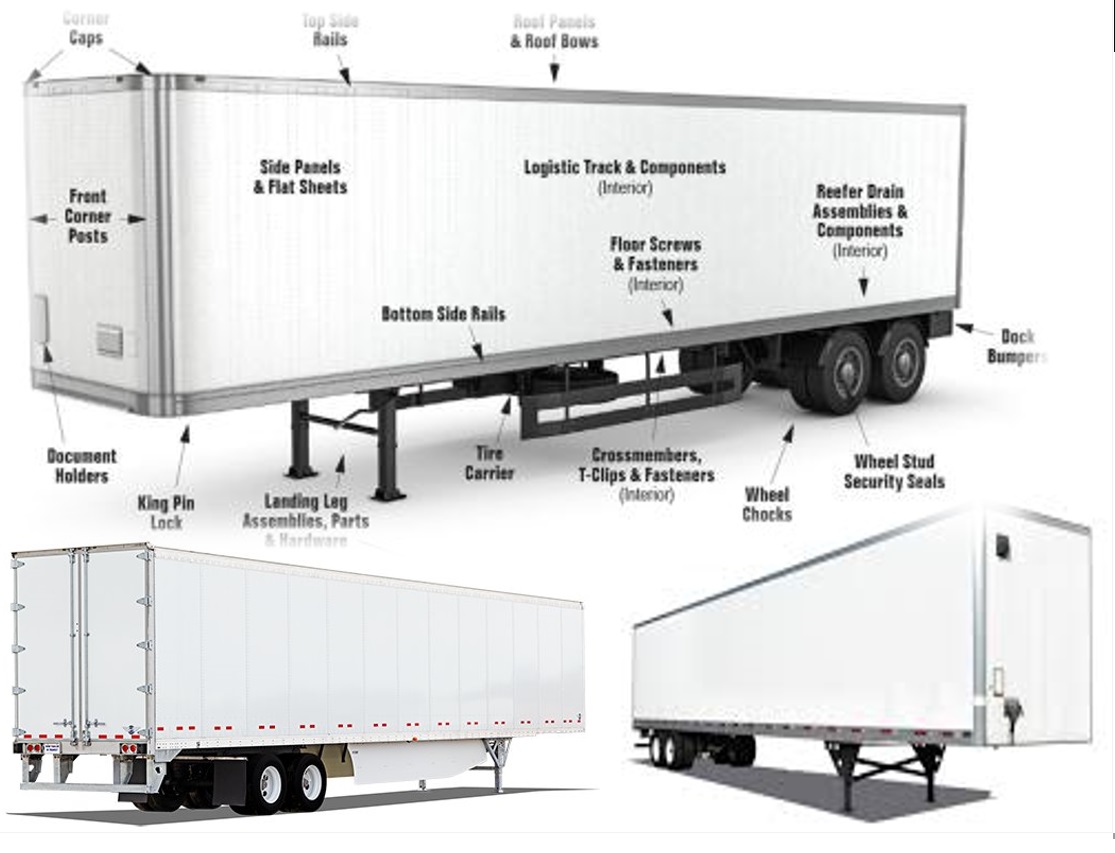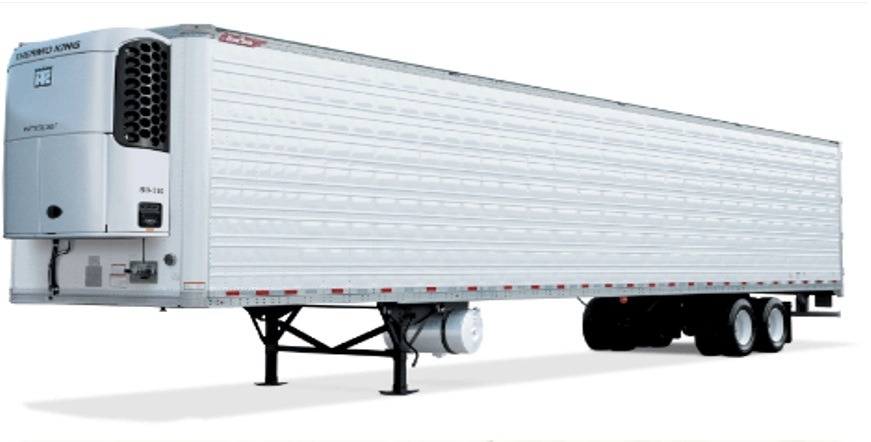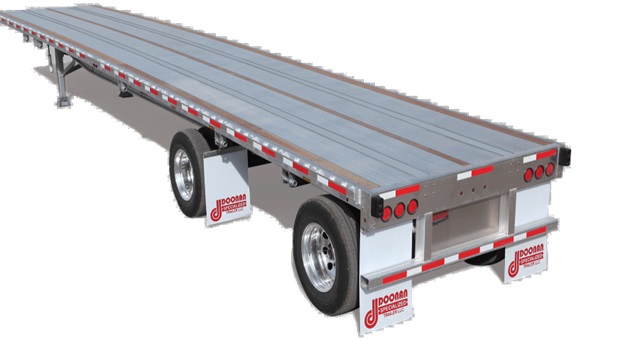
C: Trailers model in U.S and Safety Features:
A trailer is an unpowered vehicle towed by a powered vehicle, used for hauling goods, cargo, or equipment. Trailers are commonly used for transportation, logistics, and hauling heavy loads over long distances. The United States has a diverse range of trailer models designed for 10-wheel trucks, each with its unique history, features, and usage.
Here are some of the most common trailer models.
1: Dry Van Trailers: Dry Van trailers are the most common type of trailer, used for hauling dry goods such as food, clothing, and electronics. They are fully enclosed and protected from the elements.
Facts:
- Dry-Van trailers has 53feets length.
- Dry-Van trailers has 8.2- and 8.5-feet width.
- Dry-Van trailers have hardwood flooring.
- Dry vans protect your freight from theft.
- Dry-Van trailers has swing and roll door models.
Broker’s Requirements:
- Good Condition.
- Cleanness
- No whole trailer.
- E-Truck whole
- Model over 2014.

2: Refrigerated Trailers (Reefers): Designed for hauling temperature-sensitive cargo, reefers are insulated and equipped with cooling systems to maintain a consistent temperature.
Types of Refrigerated Trailers:
- 1: Single-Temperature Reefers: Maintain a single temperature setting.
- 2: Multi-Temperature Reefers: Have multiple compartments with independent temperature control.
- Cryogenic Reefers: Designed for extremely low temperatures (below -100°F) for transporting frozen goods.
Facts:
- Reefer trailers has 48-53 feet length.
- Reefer trailers has 8.5 feet width and 13.5 feet height.
- Reefer trailers comes with Aluminum, wood and composite floor.
- Reefer trailers has cooling unit, Powered by diesel engines or electric motors. These units cool the trailer using refrigerants like Freon or CO2.
Temperature requirements:
- Greens, fruits and vegetables: 32-36°F.
- Cranberries and avocados: 38-40°F.
- Green beans, potatoes: 40-46°F.
- Bananas, tomatoes, cucumbers, watermelon, some citrus: 45-50°F.
- Meat, poultry, fish, dairy: 40°F or lower.
- Pharmaceuticals: depends on the chemical compounds, but common temperature categories are room temperature (20˚C to 25˚C), refrigerated (2˚C to 8˚C), and cryogenic (below 0˚C to as low as -150˚C).
- Plants and florals: 33˚F.
Safety Points:
- Pre-Trip Inspection: The trailer's temperature, refrigeration unit, and fuel level should be checked before each trip.
- Temperature Control: The temperature as needed to maintain the required range for the cargo should be monitored and adjusted.
- Refrigeration Unit Maintenance: Regularly the refrigeration unit, including filters and fuel levels must be checked and maintained.
- Emergency Protocols: Establish protocols for emergency situations, such as refrigeration unit failure or cargo spoilage.
Broker’s Requirements:
- Good Condition.
- No whole trailer.

3: Flatbed Trailers: Used for hauling heavy equipment, construction materials, and oversized loads, flatbed trailers are open and flat, with no sides or roof.
Facts:
- Flatbed trailers are often used in industries such as construction, agriculture and logistics.
- Flatbed trailers are available in different sizes, with lengths ranging from 20 to 40 feet.
- Load capacities from 9,900 to 48,000 pounds.
- Flatbed trailers often come with ramps or dovetails for easier loading and unloading.
Safety:
- Proper Load Securement: Ensure cargo is properly tied down with chains, straps, or ropes to prevent shifting or falling off during transport.
- Load Capacity: The driver should not exceed the trailer's Gross Vehicle Weight Rating (GVWR) or payload capacity to avoid overloading and potential accidents.
- Decking Material: The driver should choose durable decking materials like hardwood or steel to withstand heavy cargo and harsh weather conditions.
- Stake Pockets and Tie-Downs: The driver should use stake pockets and tie-downs to secure cargo and prevent it from shifting during transport.
- Ramps and Dovetails: The driver should use ramps or dovetails for safe loading and unloading of cargo, especially heavy or oversized items.
- Regular Maintenance: The driver should regularly inspect and maintain the trailer's tires, brakes, lights, and other components to ensure safe operation.
- Safety Accessories: The driver should consider adding safety accessories like cargo nets, tarpaulins, or side kits to protect cargo and prevent damage.
- Compliance: Comply with relevant safety regulations, such as those set by the Federal Motor Carrier Safety Administration (FMCSA).
Pre-Trip Inspections: Conduct pre-trip inspections to identify and address any potential safety issues before hitting the road.
Broker’s Requirements:
- Good Condition.
- Safety accessories.

4: Step Deck Trailers (Drop Deck): Similar to flatbeds, but with a lower deck height, step deck trailers are ideal for hauling heavy equipment and oversized loads.
Facts:
- Step Deck trailers has 53feets length.
- Step Deck trailers 8.6 feet width.
- Step Deck trailers can carry loads up to 10 feet height.
- Step Deck trailer’s max legal weight is 46000 pounds.
- Step Deck trailers are hardwood/aluminum flooring.
- Step Deck lefts construction equipment or materials, excavators, or other machinery.
Broker’s Requirements:
- Good Condition.
- Cleanness.
.png)
